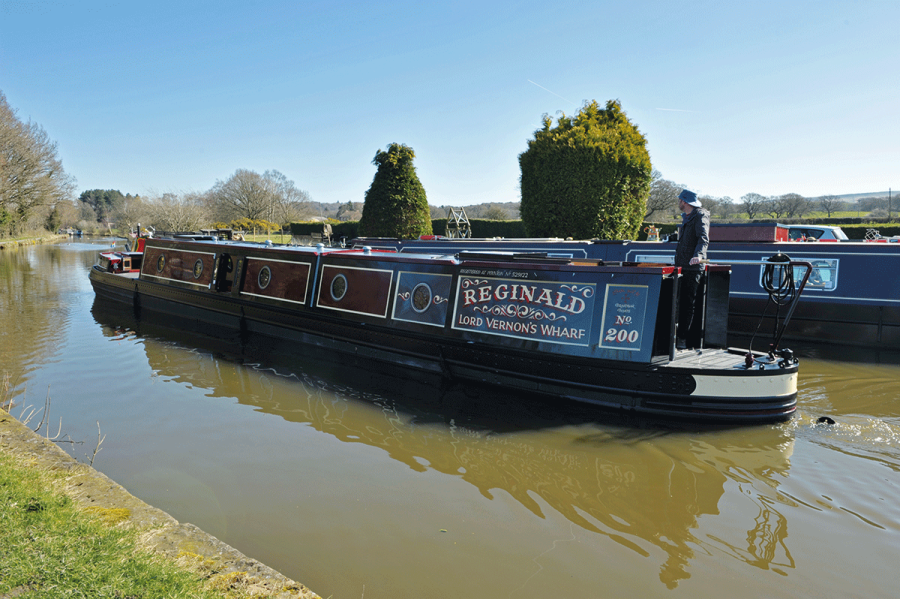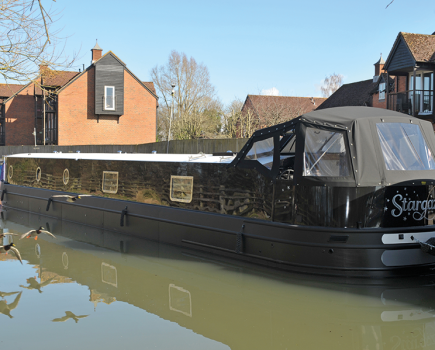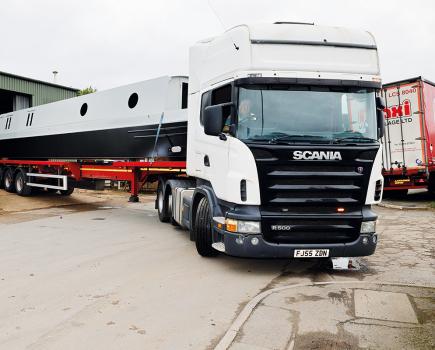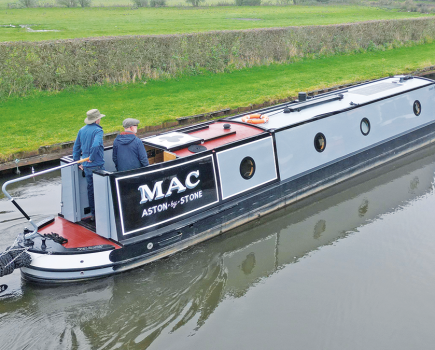There’s something very special about centuries. Reaching a hundred of anything seems like an achievement – just ask any cricketer. And reaching 200 somehow seems more than twice as good.
Words by Adam Porters | Pictures by Andy Annable
And that’s what Braidbar Boats has just done. Its 200th boat, Reginald, will be its show boat at the Crick Show this year – and the company has really worked hard to make it something special. It’s following in illustrious footsteps, because Number 100 won the vote for the Favourite Boat at the show back in 2007. In case you can’t remember the details, it was a gorgeous 70-footer with a vintage Gardner 2LW engine (that had started life as a pump in a South African mine) and a traditional back cabin with scumbling and roses and castles.
Braidbar has always had a reputation as builders of quality boats, but Reginald shows how things have moved on since 2007. Braidbar Boats has changed hands twice in the intervening years, with each set of owners ramping things up a notch. This boat has a hybrid electric drive system, all the latest monitoring technology, and a real high-end fit out which is quite special – plus a surprise under the tug deck.
EXTERIOR
Reginald is built on a fantastic 66ft shell by Tim Tyler. It’s a sheerline Josher tug with a potter’s cabin – and is a real head-turner. Sheerline refers to the sweeping gunwale line which looks just right. The tug deck is long and sleek, and has a planking effect to refer back to working tugs which would have had a hold covered in wooden planks. The potter’s cabin is the box at the bow, which is another feature which refers back to working boats, in this case those from the Potteries, which often had a small fore cabin where children used to sleep. The Josher bow has the curves you’d expect, and an imposing stem post.
But while you need to stand back to get the full effect of the lines of the boat, when you look more closely you find there are details everywhere. There are rivets along the gunwale line, and three recessed panels at the stern. There’s not only a boatman’s beam across the roof, but there’s also a cabin break, marking where a traditional boat’s engine room would have finished. The handrails protrude slightly, as they would have done in the days when they were made of wood. There are rings on the forward cabin bulkhead, and one of the stern dollies has a pleasingly chunky hook on it. The roof is noticeable flatter than most boats, too, which emphasises the traditional look. When Tim Tyler started to build this shell he promised a heavy dusting of Tyler magic – and he’s certainly succeeded. This is a boat you could look at every day and not get tired of seeing.
It’s perhaps a little surprising that a boat with so many traditional features has a semi-trad stern rather than a trad one. But semi-trads are more social, and this one has stern doors which help make it look like a trad. On a practical level, there are storage lockers on each side of the stern. There’s a large locker in the nose (this is a gas free boat, so there’s no need for a gas locker). The water tank takes up space either side of the tug deck. The colour scheme is a classic and classy combination of grey, black, and maroon. But rather than brass, which you might expect, the trim is in chrome for things such as the fairleads and the industrial-style bulkhead lights. The mushroom vents have a brushed finish. The signwriting is by Andy Russell, and is done with his usual flair.
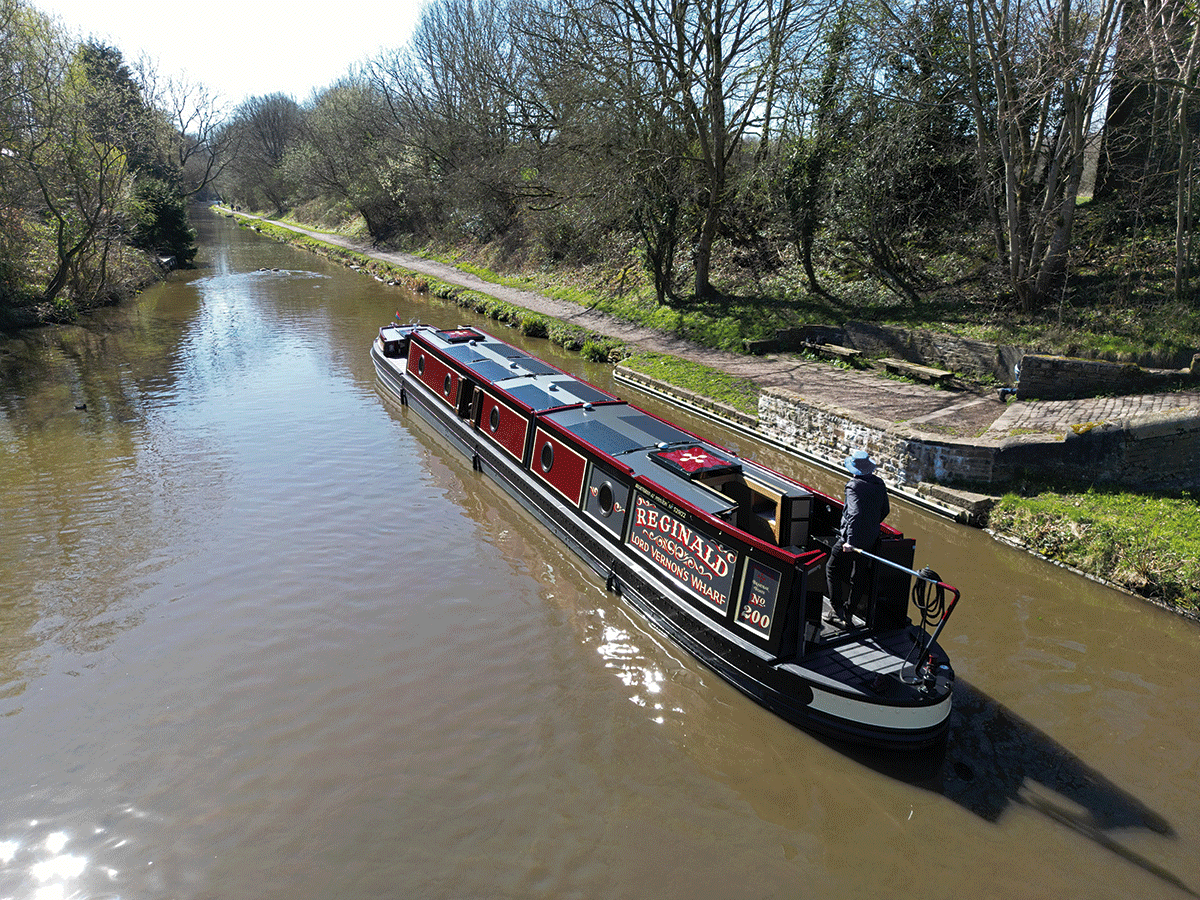
LAYOUT AND FITOUT
While lots of people like the look of a tug, many also worry about not being able to properly use the space under the tug deck. And if you look at the measurements for this boat you can see how the concern arises, because while the whole boat is 66ft long, the interior cabin space is only 40ft. Of that 40ft, the saloon is at the fore end, with a breakfast bar before you get to the galley. A walk-through shower room is next, with the cabin at the stern.
But this boat shows how you can put the space under the tug deck to good use. It has an additional bedroom under there, with its own seating area in the potter’s cabin. And as we’ll see, access to it has been cunningly disguised, to make it into a kind of secret Narnia.
The fitout uses oak, with shadow gap tongue and groove below the gunwales. The cabin sides are covered in a faux-leather vinyl, which is more normally found in yachts and super cars. It’s mould-resistant and should be easy to keep clean. It’s padded on the cabin sides, but used without the foam on the ceiling. The trim above the gunwales is oak which has been stained a black, to give a very striking finish. The same colour is used for the chunky porthole liners, and all the wood has been treated with a matt varnish, so there are no glossy surfaces.
All the joinery is in oak, and all the furniture has been made with Braidbar’s customary quality finish. Everything fits together exceptionally well, and looks and feels solidly done.
SALOON
We’ll start at the bow, where a set of glazed doors and a sliding hatch give access from the tug deck to the saloon. The steps curve down one side of the boat, and each one has a lifting tread for storage. At the top of the stairs, there’s a useful cupboard.
The whole saloon feels very high end, thanks to the striking contrast between the different wood colours, the soft cabin sides, and a central ceiling feature, which hides LED lights that flood the ceiling with light. There are under gunwale lights too, which can be set to any colour you like (or indeed you can cycle through them if you can’t make up your mind which you prefer). There’s a large leather sofabed on one side, complete with cushions in a variety of fabrics, but including one which has also been used for the porthole bungs. It’s grey, with copper highlights.
Opposite the sofa is an under-gunwale cupboard unit, with a flat screen tv standing on top. The cupboards mean that the Freeview box and other gubbins can be hidden away. There are also smart grey radiators throughout the boat.
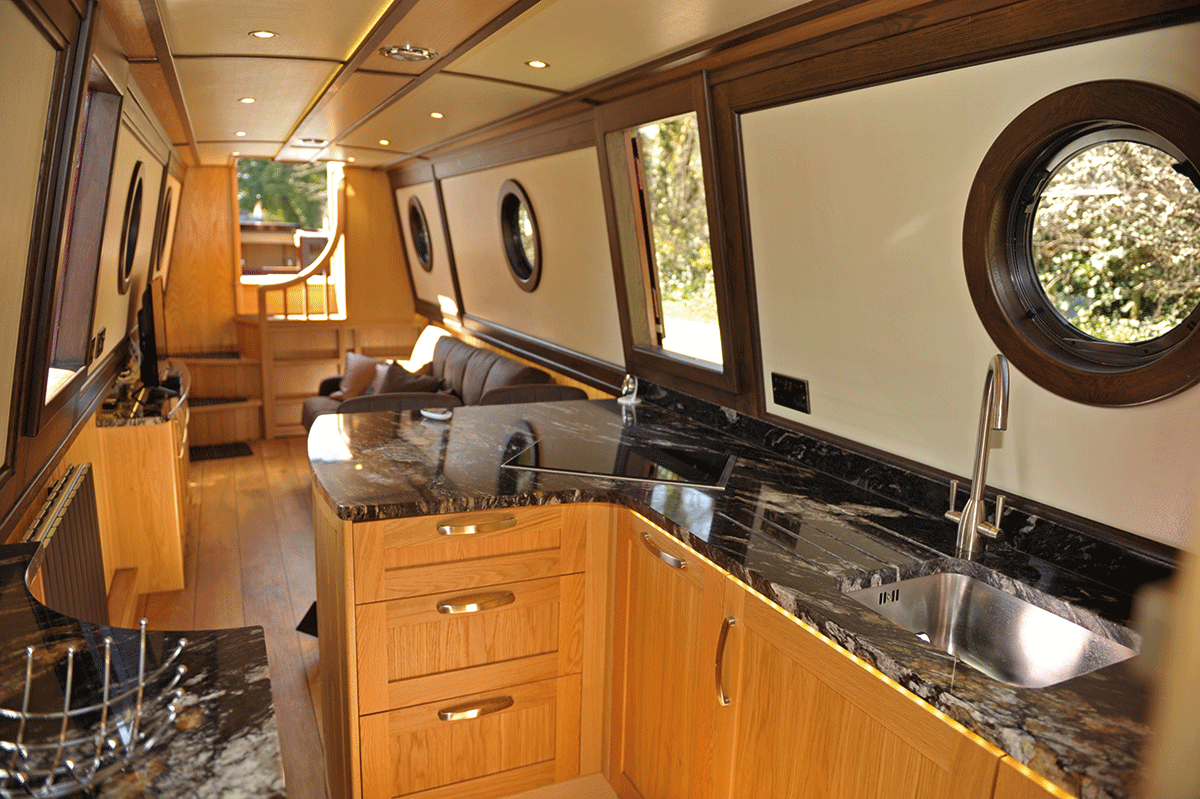
GALLEY
A breakfast bar divides the saloon from the galley, with a couple of stools giving somewhere to sit and eat. There are glazed side hatches on both sides of the boat. But the most eye catching feature is the vast expanse of granite forming the worktops and breakfast bar. The design is called cosmic black, and you can see why, with pale swirls against a dark background making it look like something you’d see through a space telescope.
Under the worktops are a range of cupboards and drawers giving plenty of storage space. One of the cupboards has a magic corner system, so there’s no unused dead space. Appliances include a slimline Bosch dishwasher, and a 240-volt fridge by the same firm. Above it, there’s a Neff electric oven with a hide and slide door, and a Neff microwave above that. Between the ovens and the cabin side there are two pullout units with shelves which are handy for cups and glasses. A Neff induction hob is set into the granite, across the corner. A washing machine is in a cupboard accessed from under the breakfast bar. It makes use of space which would otherwise be a dead corner. The main part of the galley forms a U-shape, and on the other side of the boat is a smaller unit which houses an Essentials freezer, with a drawer underneath. Alongside there’s an under-gunwale can cupboard. A wine store in the floor will keep bottles cool.

UNDER TUG CABIN
Before we leave the open-plan saloon and galley, let’s return to the front of the boat. Below the steps from the front doors there’s a shelving unit which doubles as a secret door to the second cabin. To open it, you push one side, and the shelves then bi-fold open. Inside there are some cupboards, and a double mattress which takes up the width of the floor space; the units either side are where the water tanks are.
At the head of the mattress are some cubby holes with sockets and charging points. The whole area is fitted out in exactly the same style, with vinyl panels and even the central ceiling feature. Headroom is limited, so you can’t stand up, but you can sit up in bed without banging your head, meaning you can comfortably watch the small tv that’s been installed.
Beyond the head of the bed is the seating area under the potter’s cabin. There are benches each side, and the forward bulkhead offers a range of cupboards. In the middle of the forward bulk set is a hinged ladder. Pull it out and it gives you access to the tug deck, via a pair of tiny glazed doors and a sliding hatch. This area would make an excellent guest bedroom – but even more, a child or a teenager would love a space like this. The secret access only adds to the appeal.
SHOWER ROOM
 To the aft of the galley is the shower room, which is a walk-through design. The doors at either end are made in the same contrasting way as the rest of the boat, with oak below the gunwales and black-stained oak and vinyl panels above.
To the aft of the galley is the shower room, which is a walk-through design. The doors at either end are made in the same contrasting way as the rest of the boat, with oak below the gunwales and black-stained oak and vinyl panels above.
The shower cubicle is generously sized, and is lined with a dark and moody Mermaid board. Between the cubicle and the cabin side is a pullout unit. Below there’s a cupboard which contains the calorifier (its proximity to the shower means you won’t waste a load of water waiting for the hot to come through), and the shower pump.
On the opposite side of the room there’s a corner unit with a smart basin and tap set into more cosmic black granite. Above, there’s a small unit with a mirrored door. The loo is a Sanimarine macerator; the holding tank is under the bed immediately behind, so there’s a gratifyingly short run of pipe between the two.
CABIN
The main bedroom at the stern has an in-line bed, which extends thanks to a pull out section. The mattress lifts on gas struts to give access to the storage underneath, although quite a lot of the space is taken up by the loo holding tank – although this has been nicely boxed in. There’s a run of high-level cupboards along the length of the bed, while at the head there’s a shelf with reading lights underneath. There’s a simple headboard made from the same laminate as has been used to line the shower cubicle.
A curvy shelf has been set into one corner at the back of the room, and there’s a wardrobe unit which offers hanging space and a drawer. The steps up to the stern deck hide the boat’s considerable battery bank, but most of the steps still have lifting treads. On one side is the electrical cupboard, while opposite there’s a cupboard which houses all the hybrid workings.
TECHNICAL
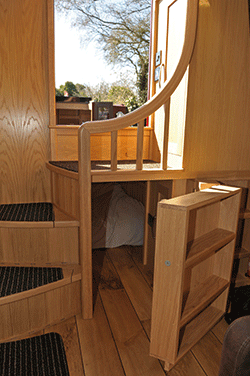 Reginald is powered by a parallel hybrid system by Hybrid Marine. It’s based on the familiar Beta 43 diesel engine, with a 10kw 48-volt electric motor added to one end. Either can drive the prop, meaning you have the option of switching between electric and diesel drive, depending on the conditions. When under diesel power, the motor turns into a generator to charge the batteries. This one also has the latest clutch system, which allows for charging from the diesel engine while moored.
Reginald is powered by a parallel hybrid system by Hybrid Marine. It’s based on the familiar Beta 43 diesel engine, with a 10kw 48-volt electric motor added to one end. Either can drive the prop, meaning you have the option of switching between electric and diesel drive, depending on the conditions. When under diesel power, the motor turns into a generator to charge the batteries. This one also has the latest clutch system, which allows for charging from the diesel engine while moored.
This boat has the enhanced package, which means the battery bank is 800Ah at 48 volts (to give an idea of how big that is, the equivalent at 12 volts would be 3200Ah). The bank is made up of 24 two volt cells, all housed in a plastic box under the rear steps so they’re contained should anything untoward happen. They are also vented to the outside, and have an automatic watering system.
There’s a remote controller for the electric motor, which means forward and reverse can be selected from the lock side, which would be particularly useful for a single-hander.
A 240-volt supply comes from a Victron 5kw inverter. There’s also a cross-charging system, so the main battery bank charges a 12-volt battery for things like the lighting and the pumps, and another two for the bow thruster. There are eight 150 watt solar panels on the roof to help keep the batteries charged. They are controlled by a Victron MPPT controller. A Victron colour touch-screen display shows the state of charge of the batteries, and what’s going in and out. There’s also an app so you can get the same information on a phone or tablet.
Central heating comes from a Webasto diesel boiler, and there’s a Nest thermostat controller, which can be operated from a phone.
ON THE WATER
I can’t remember the last time we did a boat test where we got so many positive comments from the towpath. Admittedly, the Macclesfield Canal around Higher Poynton is a popular spot for walkers and runners so there were quite a few people about – but it was still remarkable how many of them made a point of saying how beautiful Reginald looked.
And because we were using the electric motor, we could hear what people on the towpath were saying; if you’re standing on a diesel engine as you go past, you can often see people’s lips moving but not catch a thing. The quiet is one of the best things about electric drive. There’s minimal noise from the motor itself, so you can hear the water round the prop and rippling along the boat, as well as the sound of birdsong.
A colour display shows you what percentage of the motor’s power you are using, and what it is drawing from the batteries. Combined with the Victron screen, you get a very full picture of what’s going on power wise. During our test, on a sunny day in early April, we could see that the solar panels were putting more into the batteries than the motor was taking out.
Handling is excellent, as you’d expect from a Tim Tyler shell. And the bow thruster, which is a Venus 95kgf, has plenty of grunt for manoeuvring.
CONCLUSION
Braidbar has an amazing record when it comes to the public vote for the Favourite Boat at the Crick Show. When the company doesn’t win, it’s always second or third – in fact I can’t remember a year when it wasn’t placed.
And this is a stunning boat which will surely wow the Crick crowds. It does come with a hefty price tag, though, of around £300,000. That’s a lot of money – but everything about the boat is quality, and it’s loaded with features. The shell is exceptionally detailed and the fitout hits all the right notes of style and luxury. And Braidbar boats don’t have to be this expensive. A more standard fitout and conventional diesel engine would bring the price down considerably.
There are big differences between Braidbar 100 and this, the 200th boat. And whether Reginald can take the Favourite Boat title for Braidbar once again is down the public. But it’s definitely a contender, and a very strong one at that.
BRAIDBAR BOATS
 James Attwood and Donna Hitchin have been at Braidbar for more than five years now, and the firm’s 200th boat has been built as a showcase for what the firm can do. The couple will also use it for holidays, and might eventually live on board too. It’s named in memory of a much loved dog.
James Attwood and Donna Hitchin have been at Braidbar for more than five years now, and the firm’s 200th boat has been built as a showcase for what the firm can do. The couple will also use it for holidays, and might eventually live on board too. It’s named in memory of a much loved dog.
The 200th boat also marks Braidbar’s 40th anniversary. It’s worth noting that the first hundred boats took almost 25 years to build, so notching up another hundred in only 15 years shows how the company has expanded. It currently builds around six boats a year. There’s a team of staff, including joiners, engineers, and a painter – all based in a little arm off the Macclesfield Canal. The goings on there must provide endless entertainment for passers by and visitors to the Trading Post next door, as empty shells are transformed into exceptional boats.
Owners of Braidbar boats also have their own club, with a lively online discussion forum, and a get together alongside the firm’s open day in September. And the people who’ll be showing visitors around the show boat at Crick will also be existing owners..
Specification
Length: 66ft
Beam: 6ft 10in
Shell: Tim Tyler www.timtylerboats.com
Style: Semi-trad
Layout: Standard
Berths: 2+2+2
Fit-out: Oak, vinyl
Engine: Hybrid Marine www.hybrid-marine.co.uk
Inverter: Victron 5kw www.victronenergy.co.uk
Freezer: Essentials CTF34W18 www.currys.co.uk £79
Sofabed: Canterbury www.sofabedbarn.co.uk from £569
Induction hob: Neff N53TD40N0 www.neff-home.com £679
£300,000
CONTACT
Braidbar Boats
Lord Vernon’s Wharf, Lyme Road
Higher Poynton, Cheshire SK12 1TH
01625 873471
general@braidbarboats.co.uk
www.braidbarboats.co.uk
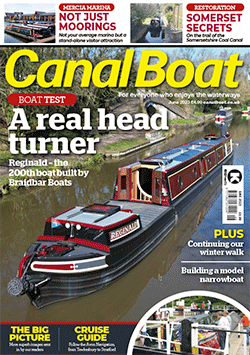 As featured in the June 2023 issue of Canal Boat. Buy the issue here
As featured in the June 2023 issue of Canal Boat. Buy the issue here

